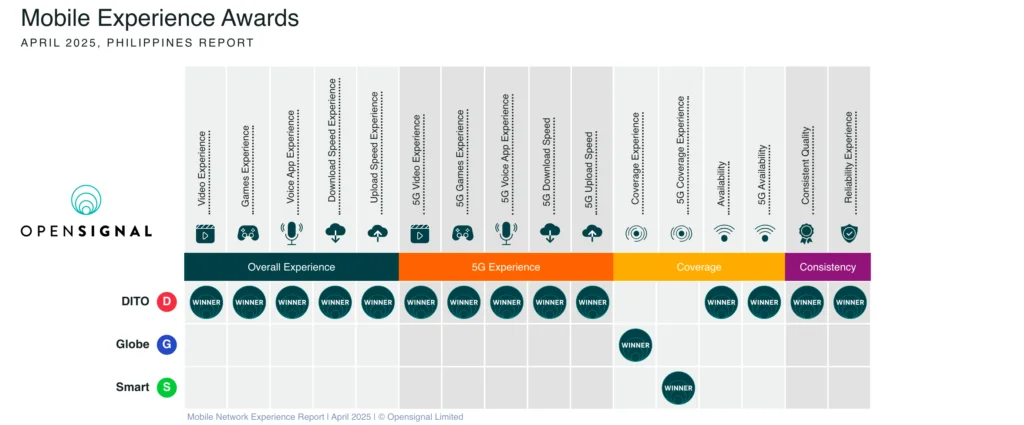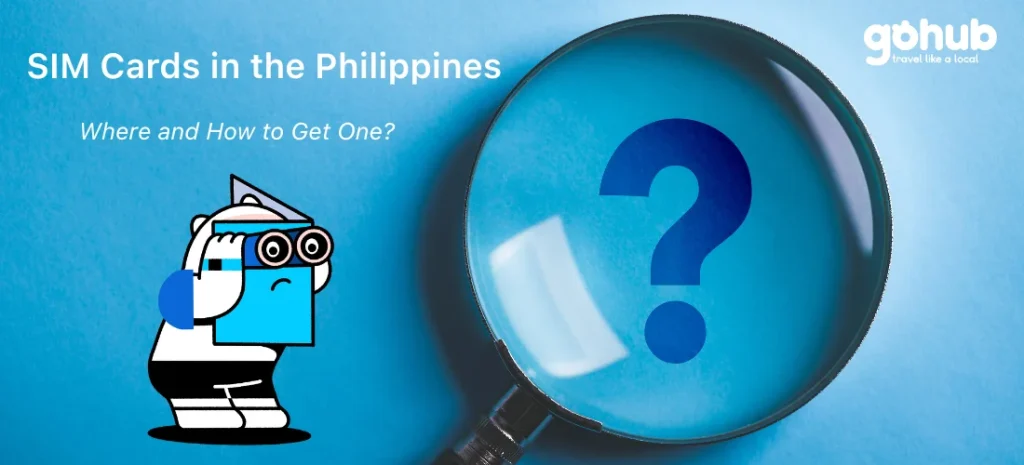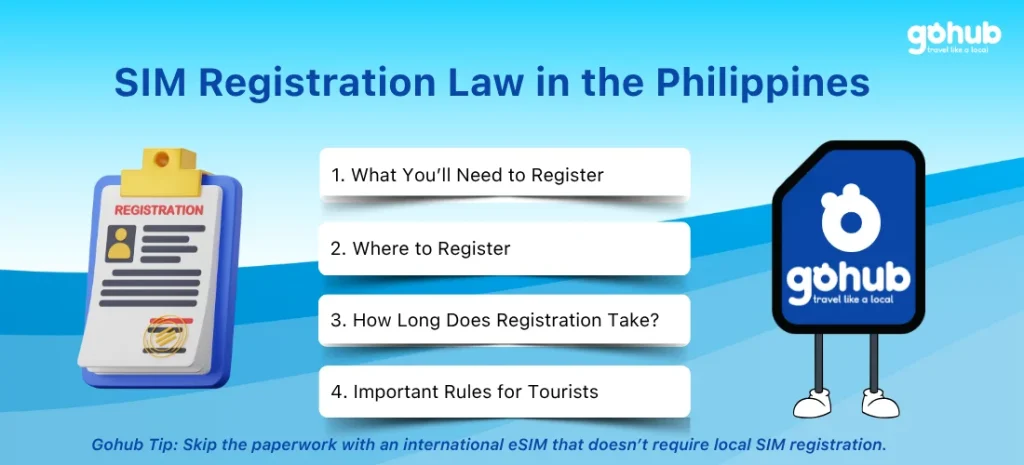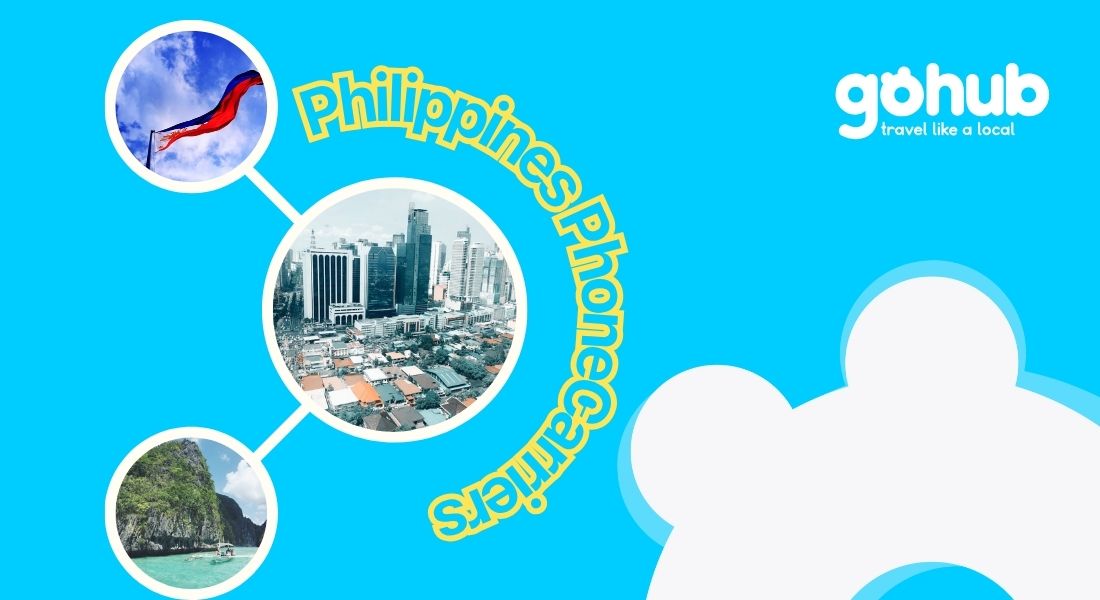Planning a trip across the stunning islands of the Philippines? Whether you’re hopping between beaches in Palawan, chasing sunsets in Boracay, or navigating the vibrant streets of Manila – one thing is essential: staying connected.
And that means understanding your Philippines phone carrier options.
Should you go with Globe, Smart, or the new player DITO? What’s the difference between using a physical SIM vs an eSIM? And what’s this talk about mandatory SIM registration?
In this guide, I’ll break down everything you need to know about Philippines phone carriers – from coverage and pricing to SIM vs eSIM comparisons – so you can stay online, stress-free, and fully in the moment on your adventure.

I. Overview of Philippines Phone Carriers
When it comes to mobile connectivity, the Philippines phone carriers market is dominated by three major players: Globe Telecom, Smart Communications, and the newer entrant, DITO Telecommunity. These carriers power the country’s mobile infrastructure, offering a mix of 4G and 5G coverage across more than 7,000 islands – with varying levels of speed, availability, and reliability.
Historically, Globe and Smart formed a duopoly, with years of investment in urban and tourist-heavy areas like Manila, Cebu, Boracay, and Palawan. In 2021, DITO entered the scene, aiming to disrupt the market with lower prices and fast 5G rollouts in metro areas.
Each carrier brings its own strengths:
- Globe is known for nationwide 4G coverage, strong performance in tourist areas, and user-friendly digital platforms.
- Smart leads in 5G availability and often delivers faster speeds, especially in cities.
- DITO offers competitive pricing and growing 5G access, but with more limited reach outside urban zones.

In addition to these primary providers, there are also MVNOs (mobile virtual network operators) that offer SIM and eSIM plans by piggybacking on the major networks — a popular choice for short-term travelers.
Understanding the differences between these Philippines phone carriers is key to choosing the best SIM or eSIM for your travel style, whether you’re a digital nomad, business traveler, or backpacking adventurer.
II. Globe vs Smart vs DITO: Coverage, Speed & Pricing
So which Philippines phone carrier is best for your trip? It depends on where you’re going, how much data you need, and what kind of traveler you are. Let’s break down the three major carriers side by side:
Globe Telecom
- Best for: Wide 4G coverage, especially in tourist hubs like Manila, Palawan, and Boracay
- Coverage: Strong nationwide 4G, limited but growing 5G in cities
- Speed: Average download speeds around 29–33 Mbps; great for browsing, social media, and video streaming
- eSIM: First provider to launch eSIM in PH; available via app and QR
- Pricing: Prepaid plans from $15–25/month
- Notable Features: Great app (GlobeOne), solid customer support in English
Globe is often seen as the most traveler-friendly, especially for popular destinations and consistent LTE/4G coverage.
Smart Communications
- Best for: 5G speed, city use, and flexible plans
- Coverage: Wide 4G in major cities, leading 5G availability in Metro Manila and Cebu
- Speed: Known for faster downloads and smoother gaming/video calls
- eSIM: Offers prepaid eSIM, but not always instantly available online
- Pricing: Prepaid plans from $12–20/month; has “Magic Data+” with no expiry
- Notable Features: GigaLife app, free YouTube/data promos
If you’re staying in urban areas and want top-tier speed for video calls or streaming, Smart may be your best bet.
DITO Telecommunity
- Best for: Budget travelers who stay in metro areas
- Coverage: Still expanding – strong in cities, weak in rural/island regions
- Speed: Surprisingly fast 5G where available, good for gaming
- eSIM: Not widely available; mostly physical SIM
- Pricing: Very affordable — $8–15/month
- Notable Features: Simple plans, high-speed data promos, low-cost international rates
Great value for money – but check your destination carefully, as DITO doesn’t work well in remote areas.
Quick Comparison Table
| Feature | Globe | Smart | DITO |
|---|---|---|---|
| Best for | Tourist areas | City speed + 5G | Budget travel |
| 4G Coverage | ✅ ✅ ✅ | ✅ ✅ ✅ | ✅ (limited) |
| 5G Availability | Moderate | ✅ Leading | Growing |
| Avg Speed | ~30 Mbps | ~35 Mbps | ~28–32 Mbps |
| eSIM Support | ✅ Easy | ✅ Limited | ❌ Mostly SIM |
| Prepaid Cost | $15–25 | $12–20 | $8–15 |
| Hotspot/Tethering | ✅ | ✅ | ✅ |
📌 Pro Tip: If you’re island hopping or going off-grid, having both Globe and Smart as dual SIMs (or a main + backup eSIM) can help avoid dreaded “no signal” moments.
III. SIM Cards in the Philippines: Where and How to Get One
Getting a SIM card in the Philippines is easy and affordable — if you know where to look. All three major Philippines phone carriers offer prepaid SIM options, and you’ll find them in both official stores and… well, some not-so-official street stalls.

Where to Buy a SIM Card
You can purchase a SIM card as soon as you land:
- At the airport: Globe and Smart kiosks are available in major airports like Manila (NAIA Terminals 1, 3, and 4), Cebu, and Davao.
- Official retail stores: Look for branded Globe/Smart/DITO stores in malls and city centers.
- Convenience stores: 7-Eleven, Ministop, and similar outlets often stock SIMs.
- Electronics shops & supermarkets
- ❌ Caution: Avoid buying from unverified street vendors. SIMs might be expired, unregistered, or even scams.
💡 Travel tip: Get your SIM at the airport if you want instant help with activation and registration (more on that next!).
How Much Does a SIM Card Cost?
- Basic prepaid SIMs cost between ₱40–₱100 ($0.70–$1.80 USD)
- Many airport vendors offer tourist bundles that include free data and setup
- You’ll need to add load (credit) afterward to activate your data plan
How to Activate Your SIM
- Insert SIM into your phone (or scan QR if using eSIM)
- Register your SIM (this is mandatory – see next section!)
- Download the carrier’s app: ( Globe → GlobeOne app; Smart → GigaLife app)
- Add load via app or top-up card
- Activate a promo immediately – don’t use data without one!
Local SIM vs eSIM (Quick Comparison)
| Feature | Local SIM | Local eSIM | International eSIM |
|---|---|---|---|
| Physical card | ✅ | ❌ | ❌ |
| Needs registration | ✅ | ✅ | ❌ (usually) |
| Instant activation | ❌ | ✅ (with Globe) | ✅ |
| Airport availability | ✅ | ❌ | ❌ (buy online) |
| Convenience | 👍 (okay) | 👍👍 | 👍👍👍 |
✨ Pro tip: If your phone supports eSIM, go digital! Fewer hassles, no tiny SIM tray tools to lose, and you can activate before arrival.
IV. SIM Registration Law in the Philippines
Starting in 2023, the Philippine government implemented a mandatory SIM registration law to combat fraud and improve digital security. This law applies to all SIM cards and eSIMs, including those used by foreign tourists.
So yes — even if you’re in the country for just a week, you’re required to register your SIM before you can use it.

What You’ll Need to Register:
- A valid passport
- A clear selfie (taken during registration)
- Basic personal info: full name, birthdate, nationality, etc.
Where to Register:
- Airport SIM booths: Staff will help you register on the spot — easiest option!
- Online portals:
📌 Note: If you get a local eSIM, you’ll still need to register it via the carrier’s website or app before it works.
How Long Does Registration Take?
- Typically 5–10 minutes at airport kiosks
- Online registration can take longer if there are upload/photo errors
- Some carriers (like Globe) allow pre-registration for eSIMs via their app
Important Rules for Tourists:
- SIMs are valid for 30 days by default (tourist visa duration)
- Want to stay longer? You must upload proof of visa extension via the carrier portal to keep your SIM active
- Unregistered SIMs will be deactivated automatically after the deadline
💡 Gohub tip: Skip the paperwork with an international eSIM that doesn’t require local SIM registration. You’ll be online in minutes — no passport uploads, no stress.
V. eSIMs in the Philippines: Local vs International Providers
If your phone supports eSIM, congratulations — you’ve just unlocked the easiest way to stay connected in the Philippines!
But before you scan that QR code, here’s the big decision:
Should you get a local eSIM from a Philippine carrier, or an international eSIM from a global provider?
Let’s break down the difference so you can pick the best fit for your travel style.
Local eSIMs (Globe & Smart)
Philippine carriers Globe and Smart both offer prepaid eSIMs for tourists.
✅ Pros:
- Direct access to local networks (no roaming)
- Potentially better speeds and latency
- Available with local data promos
⚠️ Cons:
- Still require mandatory SIM registration (just like physical SIMs)
- Not always available for instant online purchase (Smart especially)
- Some activation steps may require help from in-country staff
- ✨ Globe is the more user-friendly option: You can buy and activate via the GlobeOne app or QR code even before flying.
International eSIMs (MVNOs)
Providers like Gohub, Airalo, Nomad, and Maya Mobile offer Philippines eSIM plans that work instantly — often without any need for SIM registration.
✅ Pros:
- No SIM registration required – perfect for short-term tourists
- Instant activation (scan-and-go)
- Works across multiple networks (e.g. Globe + Smart roaming)
- Can be purchased and activated before you land
⚠️ Cons:
- May use international routing, which can affect latency slightly
- Some providers have Fair Usage Policies (FUPs) on “unlimited” plans
- Speeds can vary depending on which network they partner with
💡 Pro Tip: Gohub’s eSIM for the Philippines connects to both Smart and Globe, giving you maximum coverage without the registration hassle.
Quick Comparison: Local vs International eSIM
| Feature | Local eSIM (Globe/Smart) | International eSIM (Gohub, etc.) |
|---|---|---|
| Needs SIM Registration | ✅ Yes | ❌ No |
| Instant Activation | ❌ (not always) | ✅ Yes |
| Can be activated abroad | ❌ Usually no | ✅ Yes |
| Works on both networks | ❌ Usually one | ✅ Multi-network |
| Best for… | Long stays, locals | Tourists, digital nomads |
Recommended:
If you’re visiting the Philippines for less than a month and want zero hassle, an international eSIM like Gohub’s is your best bet. It connects to the strongest available network (Smart or Globe), doesn’t require registration, and activates instantly via QR code.
Traveling longer or on a tight budget? A local SIM or eSIM could save a few dollars — just be ready for the extra steps.
VI. Travel Tips for Using Mobile Data in the Philippines
Once you’ve picked your SIM or eSIM, here are some must-know tips to make the most of your mobile data and avoid common pitfalls while traveling in the Philippines.
1. 🔋 Always Activate a Data Plan Immediately
Once you add credit (or “load”) to your SIM, don’t use data right away — not even for 30 seconds. Without a promo activated, you’ll burn through your balance at expensive pay-per-use rates.
✅ Tip: Turn off mobile data until you’ve activated a promo using the carrier’s app:
- Globe → GlobeOne
- Smart → GigaLife
- DITO → DITO app
2. Use Dual SIM or a Backup eSIM
Coverage can vary drastically depending on where you are. Even major networks like Globe or Smart can have “dead spots” in certain areas.
✅ Strategy: Use a dual-SIM phone with both Globe and Smart, or pair a local SIM with an international eSIM as backup.
3. Expect Connectivity Gaps in Remote Areas
Even with the best carrier, you might lose signal when:
- Island hopping (especially Palawan, Siargao, or rural provinces)
- In the mountains or countryside
- During storms or heavy congestion
✅ Download offline maps and pre-save bookings, just in case.
4. Use Messaging Apps Instead of Traditional Calls
To stay in touch with home or tour operators:
- Use WhatsApp, Messenger, Viber, Skype
- These work on data and don’t require phone numbers or roaming
5. Load Credit at Convenience Stores
“Load” is prepaid credit and is available almost everywhere:
- 7-Eleven, Ministop, sari-sari stores (local corner shops)
- You can also top-up using apps or via GCash (if available)
✅ Ask the cashier for “Globe load” or “Smart load” and the amount.
6. Monitor Data Usage & Background Apps
App updates, cloud syncing, and autoplay videos can eat data fast.
✅ Go to settings and:
- Disable background data for non-essential apps
- Turn off auto-play on social apps
- Use “Lite” versions of Facebook/Instagram where possible
Quick tip: Speed and reliability are usually best early in the morning or late at night — avoid peak hours if you’re trying to upload content or make a video call.
VII. Summary: Which Philippines Carrier is Best for You?
Still deciding between Globe, Smart, and DITO? Here’s a quick recap to help you choose the best Philippines phone carrier based on your travel style:
Globe Telecom
- Best for: Popular tourist spots (Boracay, Palawan, Manila)
- Strong 4G nationwide coverage
- First to offer eSIMs, smooth app experience (GlobeOne)
- Prepaid: $15–25/month
Smart Communications
- Best for: Urban travelers, fast 5G & video calls
- Fastest download speeds, especially in Metro Manila & Cebu
- “Magic Data+” plans (no expiry) are great for flexibility
- Prepaid: $12–20/month
DITO Telecommunity
- Best for: Budget travelers staying in metro areas
- Cheapest plans ($8–15/month)
- Good for gaming & fast 5G — but coverage is still growing
- Limited reach in remote or island destinations
Gohub eSIM (best international eSIMs)
- ✅ Best for: Short-term tourists & digital nomads
Download the Gohub App to activate your Philippines eSIM in minutes.
✔️ No paperwork
✔️ No physical SIM swapping
✔️ Connect to the strongest network wherever you go (Smart or Globe)
✔️ 24/7 travel-friendly support
👉 Install the Gohub App now and travel like a local, with global coverage.
VIII. FAQ: Common Questions About Philippines Mobile Networks
1. What are the main phone carriers in the Philippines?
The three major Philippines phone carriers are Globe Telecom, Smart Communications, and DITO Telecommunity. They offer both SIM and eSIM options with prepaid plans for travelers.
2. Which carrier has the best coverage?
Globe generally has the widest 4G coverage, especially in tourist areas. Smart leads in 5G availability and speed in major cities. DITO is growing fast but still limited outside metro areas.
3. Can tourists buy SIM cards in the Philippines?
Yes! You can buy prepaid SIMs from Globe, Smart, or DITO at airports, malls, and convenience stores. Just remember: SIM registration is mandatory, and you’ll need your passport to register.
4. Are eSIMs available in the Philippines?
Yes. Both Globe and Smart offer local eSIMs, though availability varies. For maximum convenience, you can use an international eSIM (like Gohub) that requires no local registration and activates instantly.
5. What’s the easiest option for short-term tourists?
The fastest, hassle-free option is an international eSIM from Gohub. It connects to local networks like Smart or Globe, skips the SIM registration process, and can be activated before you arrive.
👉 Download the Gohub App and get online in minutes — no paperwork, no stress.
6. How much do SIMs and data plans cost in the Philippines?
- SIM cards: ~$1–2 USD
- Prepaid data plans: $8–25/month depending on the carrier and data size
- Gohub eSIMs start from ~$4/day with flexible bundles
7. Do I really need to register my SIM?
Yes — under Philippine law, SIM registration is required for both physical SIMs and local eSIMs. Tourists need to provide a passport and personal info. If unregistered, your SIM will be deactivated.
8. How long are tourist SIMs/eSIMs valid?
Most tourist SIMs/eSIMs are valid for 30 days. If you extend your visa, you’ll need to update your registration online to keep the number active.
9. What if I’m traveling to rural areas or multiple islands?
Coverage can vary. To avoid dead zones, consider using a dual-SIM setup (e.g., Globe + Smart), or use a multi-network international eSIM like Gohub’s that automatically switches to the stronger signal.








